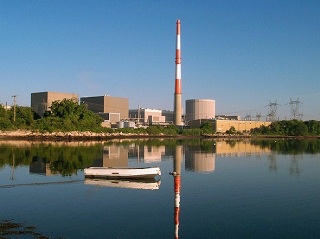Record Warm Water in Long Island Sound Shuts Down Connecticut Nuclear Power Plant
 In a sign of the severity of this summer’s record heat, one of the two reactors at Connecticut’s only nuclear power plant has been shut down due to historically high water temperatures in Long Island Sound, source of the facility’s cooling water.
In a sign of the severity of this summer’s record heat, one of the two reactors at Connecticut’s only nuclear power plant has been shut down due to historically high water temperatures in Long Island Sound, source of the facility’s cooling water.Unit 2 of Millstone Power Plant near New London was shut down Sunday afternoon after temperatures in the sound exceeded 75 degrees for 24 hours, the maximum temperature at which the nuclear power plant has permits to extract cooling water for the unit, said Ken Holt, spokesman for plant operator Dominion.
The outage in southeastern Connecticut appeared to have no immediate impact on power delivery, as the New England grid operator reported that the system operations were normal. New England was expected to have a buffer of 26 percent more electricity supply than peak demand this summer, according to a national reliability outlook published earlier this year.
But it’s a dramatic development for the water temperature in the sound to close the unit. Holt said company records dating back to 1971 show that this summer’s heat wave has led to the highest recorded water temperatures in the sound.
“It’s not that it’s been hitting 100 every day, but it’s been steady heat,” he said. “We haven’t been getting any breaks. Also we had a very mild winter, so (the sound temperatures) started from a higher point than we traditionally have.”
Holt said that Millstone’s other reactor, Unit 3, pulls water from deeper in the sound than does Unit 2, and so far has not been affected by the warm waters. However, he said the unit has the same temperature limit under which it can operate. “If temperatures continue to rise, Unit 3 will be shut down as well,” he said. (Unit 1 at the southeast Connecticut plant ceased operation in 1998 and is being decommissioned.) Together, the two Millstone reactors produce about 16 million megawatt-hours of electricity per year—enough to power 500,000 homes.
So far this summer, the Millstone unit appears to be the only U.S. nuclear power plant to face shut-down due to the record-breaking weather, the hottest July on record since 1895 and the most wide-reaching drought since 1956. Nuclear and coal power plants rely on cooling water, and past droughts and severe heat waves in the United States have shut down plants—with those located on rivers considered the most vulnerable. In Iowa, this year, authorities have watched closely the water levels in parched Cedar River, cooling water source for that state’s only nuclear power plant, Duane Arnold. Despite the drought, however, the power plant has operated near capacity all summer, except for a 5 percent reduction in output for several hours during the height of the July heat wave.
August is typically the peak month in the United States for nuclear generation, according to the industry trade group, the Nuclear Energy Institute. The NEI earlier this summer noted on its blog that more than 90 percent of the nation’s nuclear capacity remained available, despite the heat. The current operating status for all U.S. nuclear power plants can be seen here.
You can return to the main Market News page, or press the Back button on your browser.

